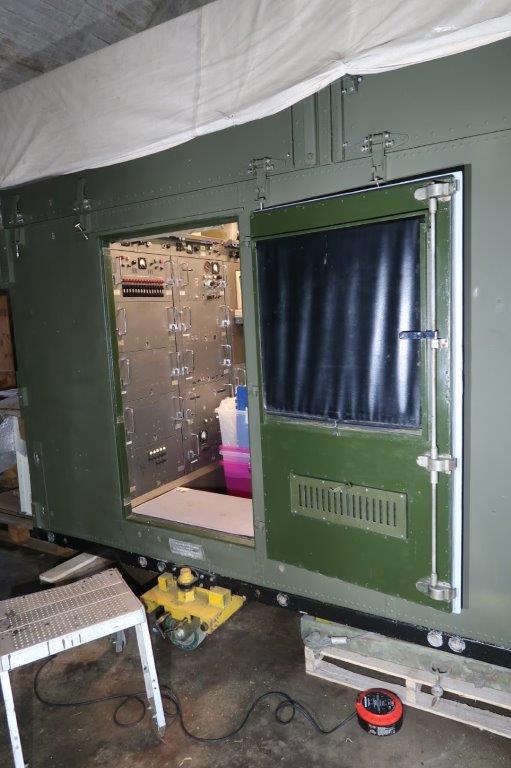19th July
T86 Pedestal Roof
More rubbing down before applying a primer. As the pedestal roof is steel I used a vehicle chassis primer so it’s now a nice overall grey.

Next visit I intend to cut some ply that we have liberated and cut it to size to give the roof surface some protection as we continue to work on the aerials. We have a circular saw but to cut the shape required I have now invested in a new reciprocating saw with plenty of spare blades!
I was getting a bit concerned about the damage to the hardwood rubbing strake on the T86 doorway caused by the steps. Some handy scaffolding just the right height provided a staging at the T86 door.

One job which I never get around to is sorting out all the T86 bits (mainly from the aerial assembly) that have been refurbished. To this end there are now several plastic storage boxes in the LCP for the purpose of getting them all together. Once sorted I can stop worrying about things like ‘where are the waveguide desiccators, they must be here somewhere’.
LCP Door Seal
The Engagement Controller’s escape door still has its seal attached which has now been removed. Pulling/cutting the seal away from the door (the seal is fixed to the door and not the cabin) left all the original Bostik glue in place which was removed using an abrasive flap thing on a drill. Once cleaned all remains of glue on the inside edge of the door in which the seal sat was primed with an etch primer. One photo shows a detail of the seal before removal (not in a good condition) and the second a view of the complete door with its edge primed. Note the door mat in the photo. The problem; the original ¼ round seals are no longer available so a search for a suitable alternative is under way.


The simulator was run up and ran for a good period. No problems in the boot sequence, no errors on the FT81 and the displays were all good. The simulator ran perfectly. Long may it continue.
24th July
It was good to be joined by Pete M and Ian for company and we got lots done. Pete and Ian did the work while I got on with collecting together previous refurbished items, mainly from the T86, which were spread around in various boxes in various places. Lots of items found which I hadn’t seen for a long while like the clips for the RF Receiver cover.
T86
Pete M has made an excellent job of repairing the hole in the steel roof below the pedestal.

The hole was caused by severe corrosion caused by water collecting on the roof which was held there by debris, mainly rotting leaves, trapped under the wooden decking slats while the T86 was in open storage. Our location ruled out welding a patch over the hole so a steel plate was riveted and sealed with a weatherproof adhesive sealant.
Ian prepared and primed the base section of the pedestal.

The lighting in the hangar could be better so Ian did mutter something about painting by torchlight! Now the base is primed we can look to replacing the Radar Absorbing Material (RAM), a rubber sheet made into a sandwich with a metal mesh. Ian finished the pedestal base in good time so he then set about painting the RAM on the pedestal frame using a rubberised roof sealing paint.
The original RAM was left in place but its surface was cracked due to the many years in the open and exposure to the elements. The first task in restoring the RAM is to skim it with weatherproof sealant and lightly rub it down before painting with rubber repair paint. Result, it looks like new.

LCP
The Harrison X150 amplifier was replaced with a spare on the basis that it’s good practice to give spares a good run, the original amplifier remains serviceable. We have a third X150 spare which will be tested next week.
Following his roof repair Pete M set up an exercise on the simulator to emulate engaging Concorde! He will refine the exercise after getting hold of accurate Concorde performance data. A good test of the exercise will be to track Concorde as a crossing target through zero doppler. The simulator remains serviceable.
Pete H




















